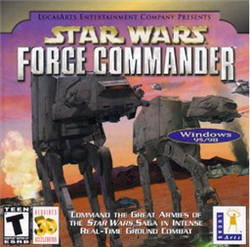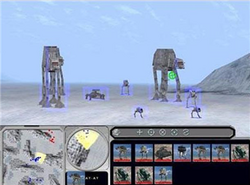Star Wars
Topic: Software
 From HandWiki - Reading time: 8 min
From HandWiki - Reading time: 8 min
| Star Wars: Force Commander | |
|---|---|
 CD jewel case cover | |
| Developer(s) | LucasArts, Ronin Entertainment |
| Publisher(s) | LucasArts |
| Director(s) | Garry M. Gaber |
| Designer(s) | Garry M. Gaber |
| Programmer(s) | Edward Kilham |
| Artist(s) | Garry M. Gaber |
| Writer(s) | Garry M. Gaber |
| Composer(s) | Peter McConnell |
| Platform(s) | Microsoft Windows |
| Release | |
| Genre(s) | Real-time strategy |
| Mode(s) | Single-player, multiplayer |
Star Wars: Force Commander is a real-time strategy video game released for the Microsoft Windows platform in 2000. It was co-developed by Ronin Entertainment and LucasArts, and published by LucasArts. Its plot interweaves between Star Wars: A New Hope and Return of the Jedi, taking place in key battles. Peter McConnell created remixed tracks of John Williams's original score with influences from hard rock and techno music.
Reception by critics was mixed. Critics cited poor controls as a primary issue. Reviewers were divided on the quality of the game's visuals, with some calling them dated and others considering them strong. Gameplay was generally considered simpler than other real-time strategy games.
Gameplay

Star Wars: Force Commander is a real-time strategy video game. The player commands forces as though they are the commander rather than an infantry unit. The game utilizes a birds-eye view around a 3D map. The levels are largely plot-focused, with initial levels playing as the Imperial faction against the Rebellion, whilst as the plot progresses and the character defects to the Rebellion, players then fight against the Imperials. Levels are ground assault based, as the game lacks space combat. Outsides of the main story-mode Campaign, scenarios can be re-played under the Scenario option, and players can set up their own battles in the Skirmish mode where up to four sides can compete against one another, though they only have the faction choice of Imperials or the Rebellion.
The game has multiple networked multiplayer options. Up to six players can join together, and Local area network (LAN) and TCP/IP connections are supported. The game was supported by the defunct Microsoft Gaming Zone.[3][4][5] LAN gameplay is limited to two players. Multiplayer mode has an instant action mode but no campaign mode. Players can choose any combination of teams or work together to challenge the computer player.[6]
Plot
The game interweaves an original story between the events of Star Wars: A New Hope and Return of the Jedi, sometimes intersecting with known Star Wars events. It is shown from the point of view of a young officer in the Imperial Navy, Brenn Tantor, who begins as a stormtrooper, but soon enough is given his own command. The first task (from the training missions) is to search for an escape pod that landed on Tatooine, and then track the droids that were inside. This is a reference to the opening scenes of Episode IV when C-3PO and R2-D2 escape the Empire via an escape pod which crashes on Tatooine.
The main character is loyal to the Empire for the first half of the game, until his brother, Dellis Tantor, discovers that the Empire killed their father. Dellis is imprisoned by the Empire for revealing this information, though Brenn is initially led to believe that Dellis has been killed. Brenn defects to the Rebel Alliance and proceeds to fight his former commanders. In addition to the Tatooine training missions, the player participates in the Battle of Hoth from the Imperial point of view, and the Battle of Endor as a Rebel. The game ends with the battle to capture the Imperial Palace on Coruscant, and ultimately the liberation of Dellis.
Development
Originally conceived as a 2D strategy game, LucasArts canceled the overall design after its first public viewing at E3 1998.[7] LucasArts instead used an optimized version of a 3D engine supplied by Ronin Entertainment,[8] delaying the game from its original late 1998 or early 1999 release timeframe to an early 2000 release. The company said it took the time to ensure innovation in this competitive genre on no exact deadline.[9] The game was jointly developed by LucasArts and Ronin Entertainment, using Ronin's programmers and engine partnered with LucasArts's project leadership, designers, and artists. The final patch for the game is version 1.1 released in March 2000. The soundtrack consists of hard rock and techno remixes of John Williams' original Star Wars scores, done by Peter McConnell.[10] More than 3,500 voice lines were recorded for the game.[11]
Reception
| Reception | ||||||||||||||||||||||||||||||
|---|---|---|---|---|---|---|---|---|---|---|---|---|---|---|---|---|---|---|---|---|---|---|---|---|---|---|---|---|---|---|
| ||||||||||||||||||||||||||||||
Star Wars: Force Commander received mixed reviews according to the review aggregation website GameRankings.[12] Greg Kasavin of GameSpot cited dated graphics, ineffective controls, and flawed gameplay as reason the game "falls short of its ambitious intent".[17] Kasavin conceded the game "has some good ideas. Its campaign has an involving plot and interesting mission objectives", and praised the 3D mission briefings.[17] Mark Hill of PC Zone said that playing from the perspective of the Galactic Empire was a "nice twist, but merely dumping this style of game into the Star Wars universe is not innovative enough."[23] Nick Woods of AllGame said that the game's 3D models were "blocky and not detailed" and added that there are "many other RTS games on the market better than this one".[13] Chris Kramer of NextGen said, "Another in a long string of Star Wars misses, Force Commander is not as bad as Rebellion, but isn't even as good as Myth II or Warzone 2100."[20] Brian Wright of GamePro said, "All in all, Force Commander feels incomplete. While a lot of care has gone into certain parts of the game, much of it seems to have been thrown in without a second thought. Star Wars fans will certainly get a kick out of reliving scenes from the movies, like hunting for the droids on Tatooine, but the game's many flaws prevent Force Commander from bringing the ultimate Star Wars battle experience to your home PC."[6][lower-alpha 1]
The game won the award for "Most Disappointing Game of the Year" at GameSpot's Best and Worst of 2000 Awards.[24]
In a feature on the history of Star Wars games, IGN's Rus McLaughlin called Force Commander "a blocky, buggy, undiluted failure".[25] A similar article in GMR Magazine from March 2004 listed Force Commander as the worst Star Wars game.[26] In the book Rogue Leaders: The Story of LucasArts, author Rob Smith said the "dated-looking visuals and clumsy controls turned off strategy gamers".[27] Hollywood.com placed it fifth in a list of worst Star Wars video games. The staff said that Force Commander had "an unwieldy camera and uninspired combat".[28] Rock Paper Shotgun's Alec Meer was also highly critical of the game. "I didn't make it past the first few levels. It was miserable."[29]
In PC Gamer's article on the history of Star Wars games on PC, author Chris Thursten called the game "ambitious but rough around the edges".[30] Craig Majaski of Gaming Age praised the game's easy learning curve, visuals and music. He praised the 3D presentation and said the models were "excellent", but noted that the camera often was difficult to control.[31] Michael Lafferty of GameZone said that, while enjoyable, Force Commander did not provide as much depth as other real-time strategy games, specifically mentioning the Command & Conquer series.[18] A CNET reviewer said that the game requires genre novices to frequently reference the documentation, but noted that "Star Wars fans and intermediate-level gamers who like third-person views" would enjoy the game.[32] Soren Johnson, then a programmer at Maxis, berated the game's "infamously difficult" camera.[33]
Notes
- ↑ GamePro gave the game two 3/5 scores for graphics and fun factor, 4/5 for sound, and 2.5/5 for control.
References
- ↑ Bye, John "Gestalt" (April 1, 2000). "UK Release Date list updated". Gamer Network. https://www.eurogamer.net/article-26778.
- ↑ IGN staff. "Star Wars: Force Commander". http://pc.ign.com/games/3732.html.
- ↑ 3.0 3.1 McElveen, Nick (April 19, 2000). "Star Wars: Force Commander". Strategy Plus, Inc.. http://www.cdmag.com/articles/027/100/forcec_review.html.
- ↑ 4.0 4.1 Clarkson, Mark (June 2000). "Forced Commander (Star Wars: Force Commander Review)". Computer Gaming World (Ziff Davis) (191): 100–1. https://www.cgwmuseum.org/galleries/issues/cgw_191.pdf. Retrieved June 24, 2021.
- ↑ Donowitz, Leo (April 18, 2000). "Star Wars: Force Commander". http://www.game-over.com/review/april2000/force/index.html.
- ↑ 6.0 6.1 Wright, Brian (March 31, 2000). "Star Wars: Force Commander Review for PC on GamePro.com". GamePro (IDG Entertainment). http://gamepro.com/computer/pc/games/reviews/5219.shtml. Retrieved August 24, 2014.
- ↑ trevicsz 198 (May 31, 2009). "Star Wars Force Commander E3 '98 trailer". Google. https://www.youtube.com/watch?v=5qSapzSVdls.
- ↑ Blevins, Tal (November 9, 1999). "Star Wars: Force Commander (Preview)". Ziff Davis. https://www.ign.com/articles/1999/11/10/star-wars-force-commander-2.
- ↑ IGN staff (October 1, 1998). "Force Commander Forced Back". Ziff Davis. https://www.ign.com/articles/1998/10/02/force-commander-forced-back.
- ↑ From Italian fan-site Lucasdelirium, its section "Biographies" (folder of Peter McConnell): "His masterpieces come in the last two years of his career as Lucasian: the incredible soundtrack of the wonderful Grim Fandango, steeped in jazz, swing and bizarre Danny Elfman (the composer for Tim Burton), as well as rearrangements in key hard-rock / techno style of John Williams's music for the Star Wars saga, for RTS Star Wars: Force Commander."
- ↑ "Star Wars at Your Command". March 6, 2000. https://www.starwars.com/gaming/videogames/news/f20000306/index.html.
- ↑ 12.0 12.1 "Star Wars: Force Commander for PC". CBS Interactive. https://www.gamerankings.com/pc/89825-star-wars-force-commander/index.html.
- ↑ 13.0 13.1 Woods, Nick. "Star Wars: Force Commander - Review". All Media Network. http://www.allgame.com/game.php?id=19123&tab=review.
- ↑ Bub, Andrew S. (April 11, 2000). "Star Wars: Force Commander". CNET. http://gamecenter.com/Reviews/Item/0,6,0-3976,00.html.
- ↑ Harris, Neil (April 7, 2000). "Star Wars: Force Commander". Greedy Productions Ltd.. http://www.elecplay.com/review.html?article=2328&full=1#mr_toppy.
- ↑ Johnny B. (April 2000). "Star Wars: Force Commander Review". CraveOnline. https://www.gamerevolution.com/review/33291-star-wars-force-commander-review.
- ↑ 17.0 17.1 17.2 Kasavin, Greg (March 24, 2000). "Star Wars: Force Commander Review". Fandom. https://www.gamespot.com/reviews/star-wars-force-commander-review/1900-2536084/.
- ↑ 18.0 18.1 Lafferty, Michael (March 27, 2000). "Star Wars Force Commander Review - PC". http://pc.gamezone.com/gzreviews/r11748.htm.
- ↑ Blevins, Tal (March 24, 2000). "Star Wars: Force Commander". Ziff Davis. https://www.ign.com/articles/2000/03/25/star-wars-force-commander.
- ↑ 20.0 20.1 Kramer, Chris (June 2000). "Star Wars: Force Commander". NextGen (Imagine Media) (66): 103. https://archive.org/details/NextGen66Jun2000/page/n105/mode/2up. Retrieved June 24, 2021.
- ↑ Werner, Nash (June 2000). "Star Wars: Force Commander". PC Accelerator (Imagine Media) (22): 74–75. https://archive.org/details/PCXL22Jun2000/page/n75/mode/2up. Retrieved June 24, 2021.
- ↑ Poole, Stephen (June 2000). "Star Wars: Force Commander". PC Gamer (Imagine Media) 7 (6). http://www.pcgamer.com/reviews/archives/review_2000-08-10ac.html. Retrieved August 24, 2014.
- ↑ 23.0 23.1 Hill, Mark (May 2000). "Star Wars: Force Commander". PC Zone (Dennis Publishing) (89): 88–89. https://archive.org/details/PC_Zone_Issue_089_2000-05_Dennis_Publishing_GB/page/n87/mode/2up. Retrieved June 24, 2021.
- ↑ GameSpot staff (2001). "Best and Worst of 2000 (Most Disappointing Game of the Year)". Ziff Davis. http://www.zdnet.com/gamespot/features/pc/bestof_2000/p4_02.html.
- ↑ McLaughlin, Russ (September 10, 2008). "IGN Presents the History of Star Wars Games". Ziff Davis. https://www.ign.com/articles/2008/09/10/ign-presents-the-history-of-star-wars-games.
- ↑ GMR. March 2004
- ↑ Smith, Rob (2008). Rogue Leaders: The Story of LucasArts. Chronicle Books. ISBN 978-0-8118-6184-7.
- ↑ Hollywood.com staff (April 4, 2013). "Farewell, LucasArts: The 10 Best 'Star Wars' Videogames". Hollywood.com, LLC. https://www.hollywood.com/movies/star-wars-videogames-lucasarts-57243045/.
- ↑ Meer, Alec (May 4, 2016). "Have You Played ... Star Wars: Force Commander?". Gamer Network. https://www.rockpapershotgun.com/star-wars-force-commander-retrospective.
- ↑ Thursten, Chris (November 17, 2015). "The complete history of Star Wars on PC (Page 2)". PC Gamer (Future plc). https://www.pcgamer.com/the-complete-history-of-star-wars-on-pc/2/. Retrieved October 22, 2023.
- ↑ Majaski, Craig (May 22, 2001). "Star Wars: Force Commander". http://www.gaming-age.com/cgi-bin/reviews/review.pl?sys=pc&game=forcecommander.
- ↑ Download.com staff (February 27, 2009). "Star Wars: Force Commander demo". CNET. http://download.cnet.com/Star-Wars-Force-Commander-demo/3000-7483_4-10042497.html.
- ↑ Johnson, Soren (November 21, 2008). "Analysis: The Quandary Of 2D Vs. 3D". Informa. https://www.gamedeveloper.com/pc/analysis-the-quandary-of-2d-vs-3d.
External links
- via the Wayback Machine
- Star Wars: Force Commander at MobyGames
- Star Wars: Force Commander on Wookieepedia, a Star Wars wiki
 |
 KSF
KSF